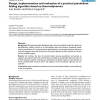Free Online Productivity Tools
i2Speak
i2Symbol
i2OCR
iTex2Img
iWeb2Print
iWeb2Shot
i2Type
iPdf2Split
iPdf2Merge
i2Bopomofo
i2Arabic
i2Style
i2Image
i2PDF
iLatex2Rtf
Sci2ools
104
Voted
BMCBI
2004
2004
Design, implementation and evaluation of a practical pseudoknot folding algorithm based on thermodynamics
Background: The general problem of RNA secondary structure prediction under the widely used thermodynamic model is known to be NP-complete when the structures considered include arbitrary pseudoknots. For restricted classes of pseudoknots, several polynomial time algorithms have been designed, where the O(n6)time and O(n4) space algorithm by Rivas and Eddy is currently the best available program. Results: We introduce the class of canonical simple recursive pseudoknots and present an algorithm that requires O(n4) time and O(n2) space to predict the energetically optimal structure of an RNA sequence, possible containing such pseudoknots. Evaluation against a large collection of known pseudoknotted structures shows the adequacy of the canonization approach and our algorithm. Conclusions: RNA pseudoknots of medium size can now be predicted reliably as well as efficiently by the new algorithm. Background Biological relevance Pseudoknots have been shown to be functionally relevant in many ...
Related Content
| Added | 16 Dec 2010 |
| Updated | 16 Dec 2010 |
| Type | Journal |
| Year | 2004 |
| Where | BMCBI |
| Authors | Jens Reeder, Robert Giegerich |
Comments (0)

